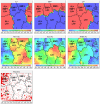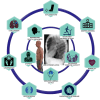Lung Hyperinflation as Treatable Trait in Chronic Obstructive Pulmonary Disease: A Narrative Review
- PMID: 38974815
- PMCID: PMC11227310
- DOI: 10.2147/COPD.S458324
Lung Hyperinflation as Treatable Trait in Chronic Obstructive Pulmonary Disease: A Narrative Review
Abstract
Lung hyperinflation (LH) is a common clinical feature in patients with chronic obstructive pulmonary disease (COPD). It results from a combination of reduced elastic lung recoil as a consequence of irreversible destruction of lung parenchyma and expiratory airflow limitation. LH is an important determinant of morbidity and mortality in COPD, partially independent of the degree of airflow limitation. Therefore, reducing LH has become a major target in the treatment of COPD over the last decades. Advances were made in the diagnostics of LH and several effective interventions became available. Moreover, there is increasing evidence suggesting that LH is not only an isolated feature in COPD but rather part of a distinct clinical phenotype that may require a more integrated management. This narrative review focuses on the pathophysiology and adverse consequences of LH, the assessment of LH with lung function measurements and imaging techniques and highlights LH as a treatable trait in COPD. Finally, several suggestions regarding future studies in this field are made.
Keywords: COPD; emphysema; hyperinflation; phenotype; treatable trait.
© 2024 Koopman et al.
Conflict of interest statement
Dr Lowie Vanfleteren reports grants and/or personal fees from AstraZeneca, GSK, Novartis, Boehringer, Pulmonx and Chiesi outside the submitted work. Dr Sami Simons reports grants and personal fees from AstraZeneca, Chiesi, Boehringer Ingelheim, GlaxoSmithKline and Roche outside the submitted work. Prof. Dr. Frits Franssen reports personal fees from AstraZeneca, Chiesi, GlaxoSmithKline, MSD and Verona Pharma outside the submitted work. The authors report no other conflicts of interest in this work.
Figures



References
-
- Corbridge T, Irvin C. Pathophysiology of chronic obstructive pulmonary disease with emphasis on physiologic and pathologic correlations. In: Casaburi R and Petty T, Principles and Practice of Pulmonary Rehabilitation. Philadelphia, PA: Saunders; 1993:18–32.
Publication types
MeSH terms
LinkOut - more resources
Full Text Sources
Medical

